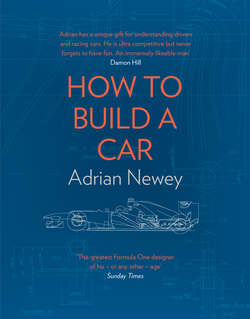Читать книгу How to Build a Car: The Autobiography of the World’s Greatest Formula 1 Designer - Adrian Newey, Adrian Newey - Страница 19
Turn Two
HOW TO BUILD A MARCH 86C
CHAPTER 17
ОглавлениеI remember being in Italy in May 1982, peering through the window of a TV shop and watching the accident that killed Gilles Villeneuve at the Belgian Grand Prix. Italian TV had no compunction about broadcasting the accident in all its horrible detail, and we were treated over and over again to images of Gilles lying in the middle of the track, his car having literally snapped in two.
I can only speculate how it must feel for other drivers seeing something like that. I’ve seen drivers on whom it has weighed heavily. Damon Hill, for example, whose own father, Graham Hill, died in a related accident, would probably admit that the risk began to affect his driving. Drivers get older, they have kids. It changes them.
As for the designer? The Ferrari in which Gilles died was one of Harvey Postlethwaite’s cars. He’d moved to Ferrari from Fittipaldi, and I recall thinking that it must have been pretty bad for him.
Tragically I was to learn how it felt the hard way. I’ve had one driver die in a car I’ve designed. Ayrton. That fact weighs heavily upon me, and while I’ve got many issues with the FIA and the way they have governed the sport over the years, I give them great credit for their contribution to improving safety in the sport.
The chassis constructor is responsible for two aspects of safety, first, trying to avoid a car component failure. Clearly if a suspension member breaks or a wing falls off at the wrong point of the circuit, the car’s going to have an accident, and if that happens it is because somebody on the team has made a mistake. It could be in the design, manufacturing, lack of inspection; it could be a mechanic forgetting to do a bolt up. There is a clause in the FIA regulations warning against unsafe construction design, but the onus is on the teams to do everything we can to put systems in place to eliminate the possibility of human error.
The second aspect of safety is what happens once the accident starts and the car hits whatever it hits; usually a wall, barrier or another car. How does it withstand the impact?
That’s the bit that is covered by regulations nowadays and it’s where the FIA has governed and legislated well, particularly as a result of the work done by the late Sid Watkins, who was the Chief Medical Officer at the FIA.
Sid was a good friend, a very good man. He started his work just after the war when motorcyclists tended not to wear helmets and would often suffer terrible head trauma in the event of an accident.
Sid understood that the best thing for injuries of this kind was to minimise swelling by keeping the body cold. His early work consisted of laying patients on a block of fish ice to keep the body temperature as low as possible. He became a brain surgeon but, after being recruited into Formula One by Bernie Ecclestone, he contributed hugely to making cars safer through his research into how to absorb energy with headrest foams, nose, side and rear-impact structures, and so on.
Back in 1986, in IndyCar, there were barely any safety regulations. You had to show your roll hoop was strong enough by calculation only, and the fuel tank bladder had to be made out of certain material and positioned between the seatback and front of the engine, but that was about it.
So the designer of the car was faced with a choice: if you come up with a design which is faster but less safe, what do you do? For instance, the driver’s feet are at the front of the car, so if the nose box isn’t robust he’s likely to badly break or even lose his legs. But a stronger nose box will be heavier.
Ultimately it was down to the designer to decide how strong to make the car versus how heavy to make it. If you did it in consultation with the drivers they would almost invariably say, ‘Make it heavier,’ and I do remember Bobby having a go at me when he felt that I hadn’t made the front-impact structure strong enough. The problem we have as a designer, of course, is that nobody thanks you for a slow, safe car. Back then I think I took the view that I had to try to make a sensible compromise; not do anything blatantly dangerous, but err towards performance over safety.
It’s a horrible position to be in. Taking that decision away from the designer is one of the best things to happen to the sport.
